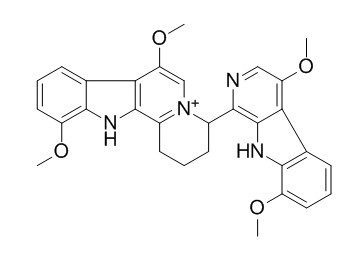Picrasidine SCAS# 112503-87-4 |

Quality Control & MSDS
3D structure
Package In Stock
Number of papers citing our products

| Cas No. | 112503-87-4 | SDF | Download SDF |
| PubChem ID | 5318873 | Appearance | Yellow powder |
| Formula | C30H29N4O4 | M.Wt | 509.6 |
| Type of Compound | Alkaloids | Storage | Desiccate at -20°C |
| Solubility | Soluble in Chloroform,Dichloromethane,Ethyl Acetate,DMSO,Acetone,etc. | ||
| Chemical Name | 4-(4,8-dimethoxy-9H-pyrido[3,4-b]indol-1-yl)-7,11-dimethoxy-2,3,4,12-tetrahydro-1H-indolo[2,3-a]quinolizin-5-ium | ||
| SMILES | COC1=CC=CC2=C1NC3=C2C(=CN=C3C4CCCC5=[N+]4C=C(C6=C5NC7=C6C=CC=C7OC)OC)OC | ||
| Standard InChIKey | ZHIAAGUQJJWYBK-UHFFFAOYSA-O | ||
| Standard InChI | InChI=1S/C30H28N4O4/c1-35-20-12-6-9-17-25-23(38-4)15-34-18(28(25)32-26(17)20)10-7-11-19(34)29-30-24(22(37-3)14-31-29)16-8-5-13-21(36-2)27(16)33-30/h5-6,8-9,12-15,19H,7,10-11H2,1-4H3,(H,31,33)/p+1 | ||
| General tips | For obtaining a higher solubility , please warm the tube at 37 ℃ and shake it in the ultrasonic bath for a while.Stock solution can be stored below -20℃ for several months. We recommend that you prepare and use the solution on the same day. However, if the test schedule requires, the stock solutions can be prepared in advance, and the stock solution must be sealed and stored below -20℃. In general, the stock solution can be kept for several months. Before use, we recommend that you leave the vial at room temperature for at least an hour before opening it. |
||
| About Packaging | 1. The packaging of the product may be reversed during transportation, cause the high purity compounds to adhere to the neck or cap of the vial.Take the vail out of its packaging and shake gently until the compounds fall to the bottom of the vial. 2. For liquid products, please centrifuge at 500xg to gather the liquid to the bottom of the vial. 3. Try to avoid loss or contamination during the experiment. |
||
| Shipping Condition | Packaging according to customer requirements(5mg, 10mg, 20mg and more). Ship via FedEx, DHL, UPS, EMS or other couriers with RT, or blue ice upon request. | ||
| Description | 1. Picrasidine S shows the potent cytotoxicity against human HeLa cervical, gastric MKN-28, and mouse melanoma B-16 cancer cells, it also shows the potent antibacterial activity against two strains of pathogenic bacteria methicillin-resistant Staphylococcus aureus (MRSA) and two strains of pathogenic bacteria methicillin-sensitive Staphylococcus aureus (MSSA). |
| Targets | Antifection |

Picrasidine S Dilution Calculator

Picrasidine S Molarity Calculator
| 1 mg | 5 mg | 10 mg | 20 mg | 25 mg | |
| 1 mM | 1.9623 mL | 9.8116 mL | 19.6232 mL | 39.2465 mL | 49.0581 mL |
| 5 mM | 0.3925 mL | 1.9623 mL | 3.9246 mL | 7.8493 mL | 9.8116 mL |
| 10 mM | 0.1962 mL | 0.9812 mL | 1.9623 mL | 3.9246 mL | 4.9058 mL |
| 50 mM | 0.0392 mL | 0.1962 mL | 0.3925 mL | 0.7849 mL | 0.9812 mL |
| 100 mM | 0.0196 mL | 0.0981 mL | 0.1962 mL | 0.3925 mL | 0.4906 mL |
| * Note: If you are in the process of experiment, it's necessary to make the dilution ratios of the samples. The dilution data above is only for reference. Normally, it's can get a better solubility within lower of Concentrations. | |||||

Calcutta University

University of Minnesota

University of Maryland School of Medicine

University of Illinois at Chicago

The Ohio State University

University of Zurich

Harvard University

Colorado State University

Auburn University

Yale University

Worcester Polytechnic Institute

Washington State University

Stanford University

University of Leipzig

Universidade da Beira Interior

The Institute of Cancer Research

Heidelberg University

University of Amsterdam

University of Auckland

TsingHua University

The University of Michigan

Miami University

DRURY University

Jilin University

Fudan University

Wuhan University

Sun Yat-sen University

Universite de Paris

Deemed University

Auckland University

The University of Tokyo

Korea University
- Aristolactam FI
Catalog No.:BCN6005
CAS No.:112501-42-5
- 6-Aldehydo-isoophiopogonone A
Catalog No.:BCN6629
CAS No.:112500-90-0
- 5-Aminoisoquinoline
Catalog No.:BCC8736
CAS No.:1125-60-6
- 4,4-Pentamethylenepiperidine hydrochloride
Catalog No.:BCC6059
CAS No.:1125-01-5
- H-Glu(OcHex)-OH
Catalog No.:BCC2929
CAS No.:112471-82-6
- U-54494A hydrochloride
Catalog No.:BCC6668
CAS No.:112465-94-8
- 3-Phenyl-1-(pyrrol-1-yl)propan-1-one
Catalog No.:BCN4005
CAS No.:112448-69-8
- AZ3146
Catalog No.:BCC3731
CAS No.:1124329-14-1
- Ganoderic acid Jb
Catalog No.:BCN7972
CAS No.:112430-68-9
- Ganoderic acid T-Q
Catalog No.:BCN3209
CAS No.:112430-66-7
- Ganoderic acid TN
Catalog No.:BCN2443
CAS No.:112430-64-5
- 2',5,7-Trihydroxy-8-methoxyflavanone
Catalog No.:BCN6004
CAS No.:112408-71-6
- Absouline
Catalog No.:BCN1954
CAS No.:112513-33-4
- Isoabsouline
Catalog No.:BCN1955
CAS No.:112513-34-5
- Neolinine
Catalog No.:BCN6564
CAS No.:112515-37-4
- Tubuloside A
Catalog No.:BCN2806
CAS No.:112516-05-9
- Citrusinol
Catalog No.:BCN8083
CAS No.:112516-43-5
- CI994 (Tacedinaline)
Catalog No.:BCC2159
CAS No.:112522-64-2
- ent-16alpha,17-Dihydroxyatisan-3-one
Catalog No.:BCN6607
CAS No.:112523-91-8
- Pioglitazone HCl
Catalog No.:BCC2278
CAS No.:112529-15-4
- 4-O-Methylepisappanol
Catalog No.:BCN3674
CAS No.:112529-37-0
- Mps1-IN-1
Catalog No.:BCC5590
CAS No.:1125593-20-5
- A 804598
Catalog No.:BCC6198
CAS No.:1125758-85-1
- SKLB610
Catalog No.:BCC3647
CAS No.:1125780-41-7
Three bis-β-carboline alkaloids from Picrasma quassioides and their bioactivities
Chinese Traditional\s&\sherbal Drugs, 2015,46 (6) :803-7.
To study the chemical constituents from the stems of Picrasma quassioides. The constituents were isolated and purified by silica gel, Sephadex LH-20, ODS column chromatographies, and preparative HPLC. Their structures were determined on the basis of their physicochemical properties and spectral data. The cytotoxic and antibacterial activities were assessed by MTT and MIC, respectively. Three β-carboline alkaloids were obtained from the 95% ethanol extract of the stems of P. quassioides and identified as picrasidine F (1), picrasidine G (2), and Picrasidine S (3). Compound 1 showed selective cytotoxicity to HeLa cell, while compounds 2 and 3 showed the potent cytotoxicity against human HeLa cervical, gastric MKN-28, and mouse melanoma B-16 cancer cells. Compounds 1-3 showed the potent antibacterial activity against two strains of pathogenic bacteria methicillin-resistant Staphylococcus aureus (MRSA) and two strains of pathogenic bacteria methicillin-sensitive Staphylococcus aureus (MSSA). The assignments of NMR data of compound 1 are reported in this paper for the first time. Compounds 1-3 show the potent cytotoxic and antibacterial activities.


